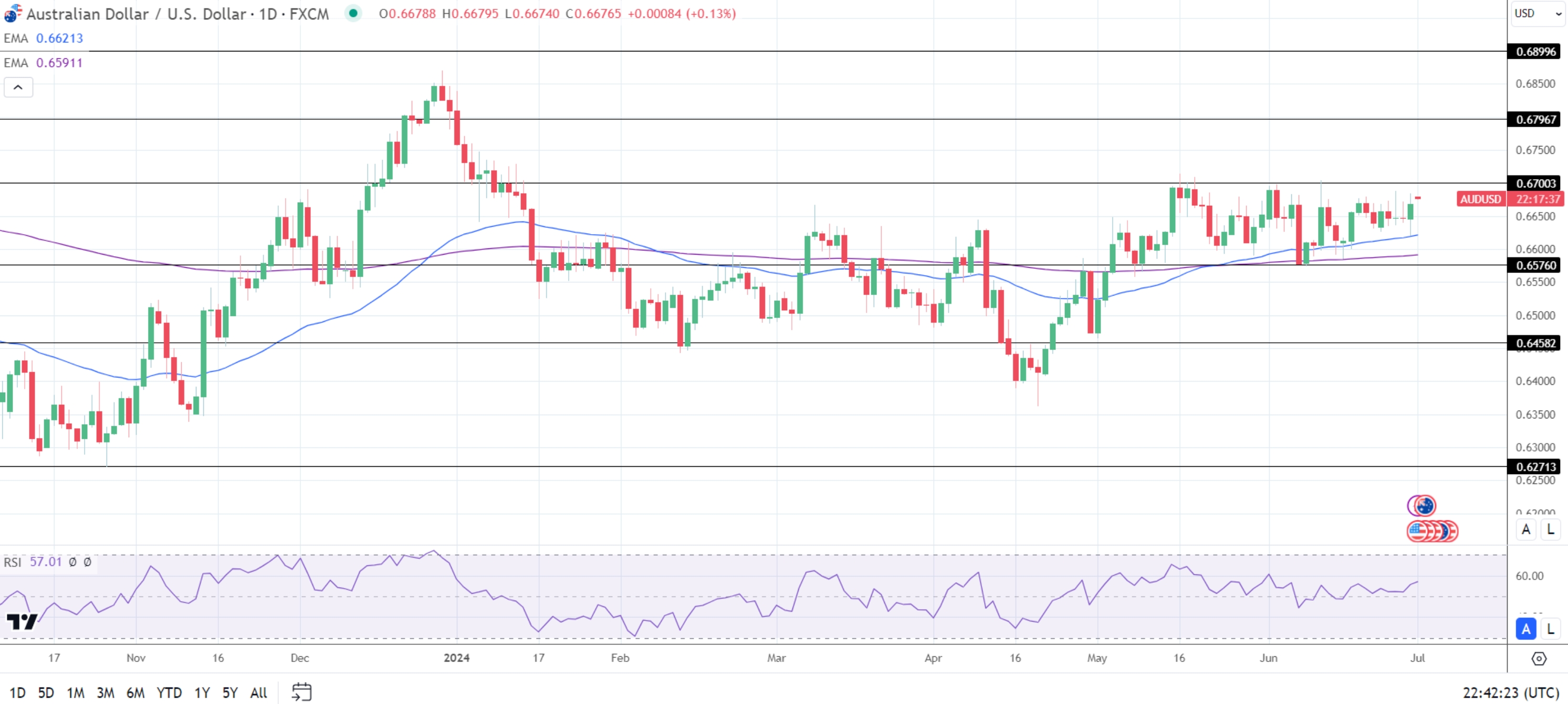Caixin Manufacturing Data Supports AUD, Analysts: May Challenge 0.6750 Resistance Upward
On Monday (July 1st), the AUD/USD fluctuated at the 0.6668 level, and the bearish downward trend seems to be limited. China's Caixin Manufacturing PMI did not fall below 50, but instead rose slightly to 51.8, and the hawkish pricing trend of the Australian Federal Reserve not cutting interest rates too early is fermenting. Technical analysis suggests that the AUD/USD will challenge the 0.6750 level before overbought.
The China Caixin Manufacturing Purchasing Managers Index rose from 51.7 to 51.8 in June, and did not unexpectedly fall below the 50 mark. The unexpected decline in Caixin Manufacturing PMI may affect the demand of Australian dollar buyers, but the situation seems to be the opposite.
According to data released on Sunday (June 30th), the manufacturing PMI of the National Bureau of Statistics remained unchanged at 49.5 in June. However, the service industry PMI of the National Bureau of Statistics decreased from 51.1 in May to 50.5 in June.
Last week, Sky News business editor Ross Greenwood discussed the interest rate paths of the Australian economy and the Reserve Bank of Australia. He said, "Although the economy is currently on the brink of recession, with a growth rate of only 0.1% last quarter, this quarter's growth rate can be negative. The reality is that under normal circumstances, you would expect the Reserve Bank to step in and start cutting interest rates to drive economic growth, but it cannot do so now."
The last time that the Australian economy shrank was in the first half of 2020, because of the COVID-19 epidemic, which is the first time that the Australian economy has experienced a technical recession in nearly 30 years.
Last month, the Federal Reserve of Australia maintained its cash interest rate at 4.35%. However, Reserve Bank of Australia Chairman Michele Bullock warned that board members discussed interest rate hikes during the central bank's monetary policy meeting.
Luci Ellis, Chief Economist of WestPacific Bank, recently predicted that the Reserve of Australia will cut interest rates for the first time in November. She said, "But we don't think they will be in a hurry, nor do we think they will cut spending quickly. Once it starts, there will be a very cautious step."
Later on Monday, the US ISM manufacturing PMI will attract investor attention. Economists predict that the ISM manufacturing PMI will rise from 48.7 in May to 49.0 in June. Exceeding the threshold of 50 will indicate an economic shift towards expansion, enhancing investor confidence in the soft landing scenario. However, these data are unlikely to affect the interest rate path of the Federal Reserve.
Manufacturing accounts for less than 30% of the US economy, limiting its impact on monetary policy. In the long run, the ISM manufacturing PMI remained below 50 in the fourth quarter of 2023, indicating that the industry is shrinking. Nevertheless, the US economy continued to grow by 3.4% in the same quarter, prompting the Federal Reserve to maintain high interest rates for an extended period of time.
Other data includes the final value of S&P's global manufacturing PMI for June, and any modifications to the initial value may affect confidence in the US economy. Preliminary investigation shows that S&P's global manufacturing PMI has risen from 51.3 to 51.7. Although the impact of these statistics may be minimal, statements from members of the Federal Open Market Committee may affect market trends.
In terms of short-term forecasts, the short-term trend of the Australian dollar/US dollar will depend on Australian labor market data and China PMI data. The worsening threat of economic recession in Australia will affect buyer demand for the Australian dollar.
AUD/USD Technical Analysis
FXEmpire analyst Bob Mason stated that the AUD/USD is still much higher than the 50 day and 200 day EMAs, confirming a bullish price signal.
The Australian dollar/US dollar broke through the resistance level of 0.67003 US dollars, which will support the Australian dollar/US dollar to return to the level of 0.67500 US dollars. In addition, breaking through $0.67500 may indicate that the AUD/USD will fall towards the resistance level of $0.67967.
On the contrary, if the AUD/USD falls below the $0.66500 mark, it may cause bears to hit near the 50 day moving average. Breaking below the 50 day moving average may indicate a drop to the 200 day moving average and support level of $0.65760.
The daily RSI reading for 14 cycles is 57.01, and the Australian dollar may climb to around $0.67500 before entering the overbought zone.

Tips:This page came from Internet, which is not standing for FXCUE opinions of this website.
Statement:Contact us if the content violates the law or your rights
